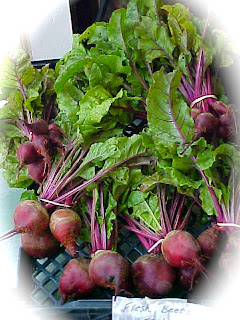BEETS
While canned beets retain most of their, sweet natural flavor if they are not pickled, fresh beets have twice the folate (folic acid) and potassium of canned beets. If the green tops are prepared, then beta-carotene, calcium, and iron are also introduced into the meal.
Beets can stain, so many people prefer wearing gloves working over a prepared area (such as cutting board or even newspaper).
After harvesting, we lovingly bathe our beets in order to freshen them, and remove as much soil residue as possible.
Beets can stain, so many people prefer wearing gloves working over a prepared area (such as cutting board or even newspaper).
After harvesting, we lovingly bathe our beets in order to freshen them, and remove as much soil residue as possible.
PREPARATION: Most people prefer boiling or roasting beets to prepare for use. Either way, it usually takes about 45-60 minutes to make the beets tender and easy to peel. Because boiling beets promotes bleeding and the loss of nutrients, steaming them in their skin is preferred by many cooks. The jackets will slip off easily, and the beets are ready for salads and other preparations. Steaming takes about 35 to 40 minutes, depending on their size. Microwaving with small amounts of water takes about half that time.
 |
| Beet Field |
Together, roasted beets and meats, especially pork and duck, make delicious meals. Onion or a touch of garlic helps to accent the sweetness if a contrast is desired. Beet greens should be handled like cooking greens.
says:
The root is rich source of phytochemical compound Glycine betaine. Betaine has the property of lowering homocysteine levels in the blood. Homocysteine, one of highly toxic metabolite, promotes platelet clot as well as atherosclerotic-plaque formation which is otherwise can be harmful to blood vessels. High levels of homocystiene in the blood results in the development of coronary heart disease (CHD), stroke and peripheral vascular diseases.
The root is also rich source of Niacin (vit B-3), Pantothenic acid (vit.B-5), Pyridoxine (vit.B-6) and carotenoids, and minerals such as iron, manganese and magnesium.
In addition, this root veggie indeed has very good levels of potassium. 100 g fresh root has 325 mg of potassium or 7% of daily requirements. Potassium lowers heart rate and regulates metabolism inside the cells by countering detrimental effects of sodium.
Please click on the chart below to view a readable size.
Our beets are gathered a little at a time in order to bring fresh, nutritious veggies to your table for a couple of months during harvest time.








